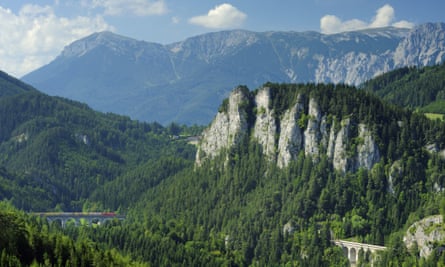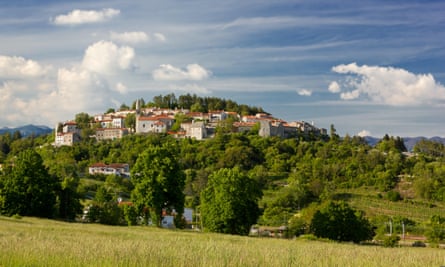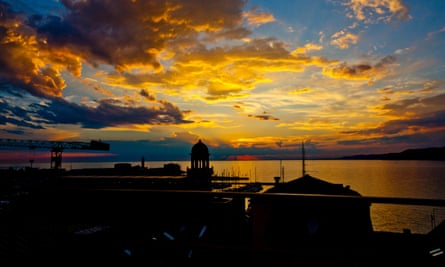[ad_1]
Vienna is Europe’s best-connected capital city, at least in terms of rail links. Weekly direct services to Minsk and Monaco slipped from the departure boards during the pandemic, but new services over the past couple of years include direct trains to Paris, Amsterdam, Genoa, Split and Trieste.
As the Habsburg empire’s main Adriatic seaport, Trieste had good rail services to Vienna, but after the first world war, politics and geography conspired against it, leaving the city on a finger of land only tenuously connected to the rest of Italy. For decades Trieste was what the late Jan Morris described as “an allegory of limbo”, and a railway backwater.
The end of the cold war, and Slovenia’s later accession to the EU and Schengen area, brought new life and opportunity to Trieste. The rail link to Ljubljana was restored. Then, in June 2021, a direct train from Vienna was added. The daily Eurocity train from the Austrian capital takes just over nine hours.

It is a tremendous journey, and well suited to the dark days of January, when slow travellers must choose their route carefully. Sunrise in Vienna is about 7.40am in mid-January, perfect for a daylight departure at 7.58am. The route includes the celebrated Semmering railway, some tantalising Styrian landscapes and the Slovenian karst. If the train reaches Trieste punctually, as it usually does, its arrival coincides with dusk over the Adriatic. With the sun dipping into the Golfo di Trieste, the train does a loop past Prosecco and the city’s northern seaside suburbs to Trieste Centrale station.
But it’s not just that final descent from the dry limestone karst to the sea that makes this journey so memorable. The appeal lies in the medley of andscapes and the political and social context of the journey. The must-take book for this trip is Jan Morris’s Trieste and the Meaning of Nowhere.
The Eurocity Emona
Our Eurocity train to Trieste is called Emona, after the early Roman settlement on what is now Ljubljana. In 2023, this train usually has six carriages, three Slovenian and three Austrian, with only the Austrian ones running through to Trieste.
The Emona ticks all the boxes for the ultimate rail cruise. Stunning mountain scenery, with a good mix of distant panoramas and closeup views, is all the better viewed from a very comfortable train which, rather than dashing to its destination, glides gracefully through the hills.

The Slovenian offering includes a nicely retro restaurant car offering breakfast essentials including fried eggs and prosciutto (dry-cured ham) and endless coffee before its scheduled removal from the train in Ljubljana, along with the other two Slovenian carriages.
Over the Semmering

The first part of the journey to Trieste follows the Semmering railway, which links Vienna with Austria’s second city, Graz. Modern trains make light of the steep gradients, but in the 1840s they posed a tough engineering challenge.
Nurtured by Habsburg imperial ambition, the Semmering railway opened in 1854. In 1998, it gained Unesco listing as “one of the greatest feats of civil engineering during the pioneering phase of railway building”.
The villages around the line have fabulous turn-of-the-century villas built for wealthy Viennese who were delighted to find the Alps now within striking distance of the capital. No surprise perhaps that these communities figured prominently in the literary and cultural imagination of end of century Vienna. The intelligentsia used the Semmering area as a rural annexe to the capital’s coffee houses and salons. Semmering was not an escape from Vienna; it was Vienna in the mountains. And Trieste was Vienna-by-the-sea.
Dropping down from the hills, we follow the Mürz and Mur valleys to Graz, where the restaurant car becomes the preserve of Styrian beer drinkers who seem immensely proud of Graz’s progressive politics. The city’s communist mayor, Elke Kahr, has presided over civic affairs since late 2021.
Slovenian transit

By midday, we are well into Slovenia and after a stop in Ljubljana, our now-truncated train crosses a beautiful area of seasonally flooded marshland, which looks wonderful even on a dull day. Slowly the railway gains height, swapping valley landscapes for more challenging arid limestone hills. In the days of steam, the lack of water for topping up locomotives was a problem.
We pause at Gornje Ležeče, once the hub of an ambitious network of aqueducts providing water to this arid land. The steam engines of the Austrian Southern Railway would stop here to draw from a reservoir in a trackside building which still stands. Today it is half-covered in ivy and a nice reminder of a Habsburg engineering prowess.
At 4pm, we slip over the Italian border and reach the first station in Italy. Villa Opicina is a shadow of its former self, but still has some of its cold war mystery. Villa Opicina often plays a bit-part role in spy novels – sometimes under its former name, Poggioreale Campagna. The name was changed to Villa Opicina in the 1960s. Ian Fleming wrote about James Bond’s arrival here from Yugoslavia in From Russia with Love.

From Villa Opicina, it is downhill all the way to Trieste, with our train looping gently down to the coast for the final run into Trieste’s elegant Centrale station, along the way passing Miramare Castle, the waters around which are still haunted by the spirit of the late, great Jan Morris.
Travel notes
Eurocity train EC151 leaves Vienna daily at 7.58am, stops in Ljubljana at 2pm and reaches Trieste at 5.16pm. The train number mysteriously changes to EC134 during the stop in Ljubljana. Singles to Trieste, from €29.90, are available online at ÖBB Austrian Railways or Rail Europe. Holders of Interrail passes have to pay a small surcharge of €2.60 in second class and €4.60 in first class.
The 17th edition of Nicky Gardner’s book, Europe by Rail: The Definitive Guide, is available from Guardian Bookshop. She is co-editor of Hidden Europe magazine
[ad_2]
Source link




